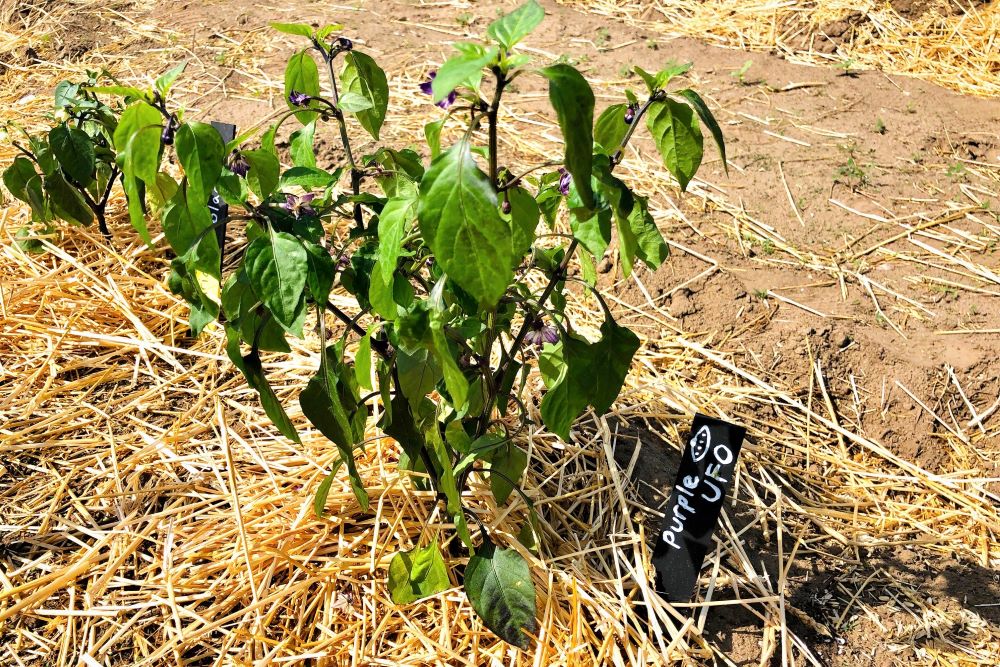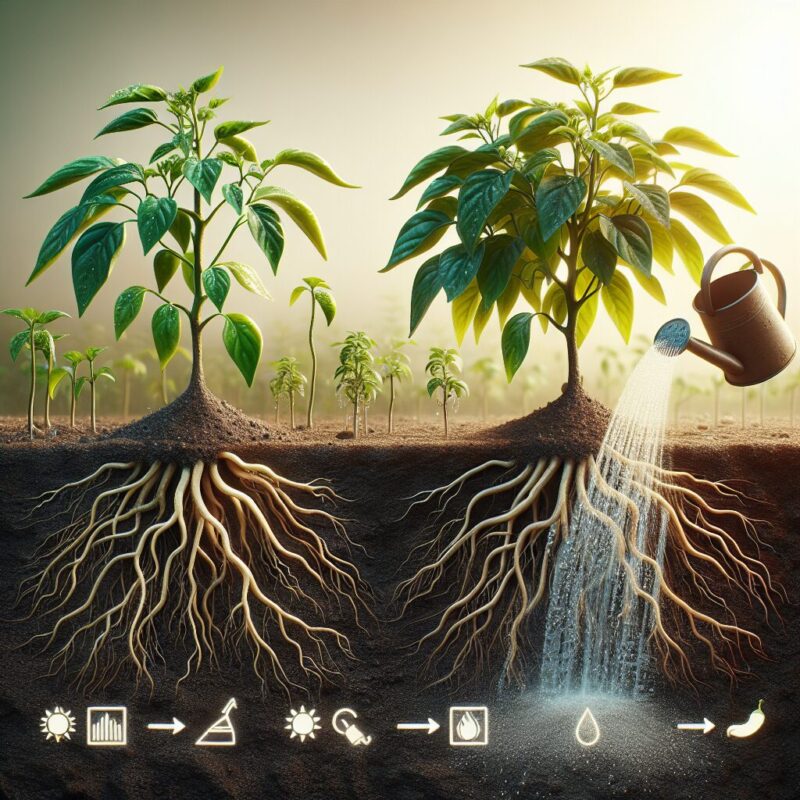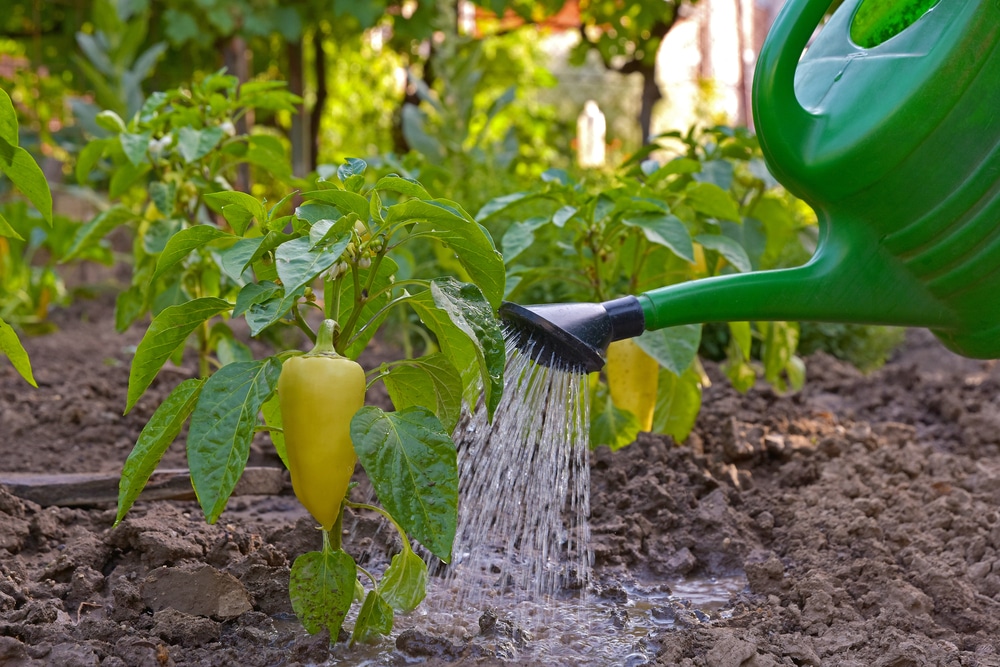Understanding the Watering Needs of Pepper Plants
Proper watering is crucial for the health and productivity of pepper plants. When to water pepper plants is a common question among gardeners, and the answer lies in understanding the unique watering needs of these plants. Unlike other plants, pepper plants require consistent moisture, especially when they’re producing fruit. Inadequate watering can lead to reduced fruit production, stunted growth, and increased susceptibility to disease.
Pepper plants have different watering needs compared to other plants due to their specific growth habits and requirements. For instance, pepper plants have a deep taproot that allows them to access water deep in the soil, but they also have a shallow root system that requires consistent moisture. This means that pepper plants need to be watered regularly, but not excessively, to prevent waterlogged soil and root rot.
When to water pepper plants also depends on the climate and weather conditions. In hot and dry weather, pepper plants may need to be watered more frequently to prevent water stress. On the other hand, in cool and rainy weather, pepper plants may require less water to prevent overwatering. By understanding the specific watering needs of pepper plants, gardeners can optimize their watering schedules to promote healthy growth and fruit production.
It’s also important to note that pepper plants have different watering needs at different growth stages. For example, seedlings require more frequent watering than mature plants, while fruiting plants require consistent moisture to support fruit production. By adjusting watering schedules according to the growth stage of the plant, gardeners can ensure that their pepper plants receive the right amount of water at the right time.
How to Check the Soil Moisture of Your Pepper Plants
Checking the soil moisture of your pepper plants is crucial to determine when to water them. There are several methods to check the soil moisture, and the most effective ones are the finger test, soil moisture meter, and observing the plant’s signs of water stress or excess moisture.
The finger test is a simple and effective method to check the soil moisture. Insert your finger into the soil up to the first knuckle, and if the soil feels dry, it’s time to water your pepper plants. If the soil feels moist, wait another day or two before checking again. This method is especially useful for seedlings and young plants that require consistent moisture.
A soil moisture meter is another accurate method to check the soil moisture. This device measures the moisture levels in the soil and provides a reading on a scale. Most soil moisture meters are easy to use and provide accurate readings. By using a soil moisture meter, you can determine the exact moisture levels in the soil and adjust your watering schedule accordingly.
Observing the plant’s signs of water stress or excess moisture is also an effective method to determine when to water your pepper plants. If the leaves are droopy or wilted, it may be a sign that the plant needs water. On the other hand, if the leaves are yellow or dropping, it may be a sign of overwatering. By observing the plant’s signs, you can adjust your watering schedule to prevent water stress or excess moisture.
When to water pepper plants also depends on the soil type and climate. For example, if you’re growing pepper plants in a hot and dry climate, you may need to check the soil moisture more frequently to prevent water stress. On the other hand, if you’re growing pepper plants in a cool and rainy climate, you may need to check the soil moisture less frequently to prevent overwatering.
The Best Time to Water Pepper Plants for Optimal Growth
When to water pepper plants is a crucial aspect of their care, and the timing of watering can significantly impact their growth and productivity. The best time to water pepper plants is in the morning or early afternoon, when the sun is not too intense. This allows the plants to absorb the water throughout the day, reducing the risk of fungal diseases that thrive in moist conditions.
Avoiding overhead watering is also essential, as it can lead to water spots on the leaves and crown of the plant. Instead, water at the base of the plant, allowing the soil to absorb the moisture. This method also helps to prevent washing away nutrients and fertilizers.
Adjusting watering schedules based on weather conditions is also crucial. During hot and dry weather, pepper plants may require more frequent watering to prevent water stress. On the other hand, during cool and rainy weather, pepper plants may require less water to prevent overwatering.
It’s also important to consider the soil type and climate when determining the best time to water pepper plants. For example, if you’re growing pepper plants in a hot and dry climate, you may need to water them more frequently to prevent water stress. On the other hand, if you’re growing pepper plants in a cool and rainy climate, you may need to water them less frequently to prevent overwatering.
When to water pepper plants also depends on the growth stage of the plant. Seedlings, for example, require more frequent watering than mature plants. By adjusting the watering schedule based on the growth stage of the plant, you can ensure that your pepper plants receive the right amount of water at the right time.
Watering Pepper Plants at Different Growth Stages
When to water pepper plants depends on the growth stage of the plant. Seedlings, for example, require more frequent watering than mature plants. During the seedling stage, pepper plants need consistent moisture to develop a strong root system. Watering once a day or every other day is usually sufficient, depending on the climate and soil type.
During the transplanting stage, pepper plants require more water to help them establish a strong root system in their new environment. Watering every day or every other day is usually necessary, depending on the climate and soil type.
Once pepper plants reach the fruiting stage, they require more water to support fruit production. Watering every day or every other day is usually necessary, depending on the climate and soil type. It’s also important to provide support for the plants, such as cages or trellises, to help them grow upright and produce more fruit.
During the maturity stage, pepper plants require less water, as they are no longer producing new fruit. Watering every 2-3 days is usually sufficient, depending on the climate and soil type.
It’s also important to note that pepper plants have different watering needs during different weather conditions. During hot and dry weather, pepper plants may require more frequent watering to prevent water stress. On the other hand, during cool and rainy weather, pepper plants may require less water to prevent overwatering.
By adjusting the watering schedule based on the growth stage of the plant, you can ensure that your pepper plants receive the right amount of water at the right time. This will help promote healthy growth, fruit production, and overall plant health.
Factors That Affect Watering Frequency for Pepper Plants
When to water pepper plants depends on several factors, including climate, soil type, container size, and temperature. Understanding these factors can help you adjust your watering schedule to ensure your pepper plants receive the right amount of water.
Climate is one of the most significant factors that affect watering frequency. In hot and dry climates, pepper plants may require more frequent watering to prevent water stress. On the other hand, in cool and rainy climates, pepper plants may require less water to prevent overwatering.
Soil type is another important factor to consider. Well-draining soils, such as sandy or loamy soils, may require more frequent watering, while heavy clay soils may require less water.
Container size is also a factor to consider. Pepper plants grown in small containers may require more frequent watering, while those grown in larger containers may require less water.
Temperature is another factor that affects watering frequency. In warm temperatures, pepper plants may require more water to prevent water stress, while in cool temperatures, they may require less water.
For example, if you’re growing pepper plants in a hot and dry climate, you may need to water them every day or every other day. On the other hand, if you’re growing pepper plants in a cool and rainy climate, you may only need to water them every 2-3 days.
By understanding these factors and adjusting your watering schedule accordingly, you can ensure your pepper plants receive the right amount of water and thrive.
Common Mistakes to Avoid When Watering Pepper Plants
When to water pepper plants is a crucial aspect of their care, and making mistakes can lead to reduced growth, fruit production, and overall health. Here are some common mistakes to avoid when watering pepper plants:
Overwatering is one of the most common mistakes made when watering pepper plants. This can lead to root rot, nutrient deficiencies, and reduced fruit production. To avoid overwatering, check the soil moisture regularly and adjust your watering schedule accordingly.
Underwatering is another common mistake made when watering pepper plants. This can lead to water stress, reduced growth, and reduced fruit production. To avoid underwatering, make sure to water your pepper plants regularly, especially during hot and dry weather.
Getting water on the leaves or crown of the plant is also a common mistake made when watering pepper plants. This can lead to fungal diseases and reduced fruit production. To avoid this, water at the base of the plant, avoiding the leaves and crown.
Not adjusting the watering schedule based on weather conditions is also a common mistake made when watering pepper plants. This can lead to overwatering or underwatering, depending on the weather. To avoid this, adjust your watering schedule based on the weather, taking into account factors such as temperature, humidity, and rainfall.
By avoiding these common mistakes, you can ensure that your pepper plants receive the right amount of water and thrive.
Using Mulch and Other Techniques to Conserve Water
Conserving water is essential for pepper plants, especially during hot and dry weather. One effective way to conserve water is by using mulch. Mulch helps to reduce evaporation, suppress weeds, and regulate soil temperature.
There are several types of mulch that can be used for pepper plants, including organic mulch like straw, bark chips, and grass clippings. These types of mulch help to retain moisture in the soil, reduce soil temperature, and prevent weeds from growing.
In addition to mulch, there are other techniques that can be used to conserve water for pepper plants. One technique is to use drip irrigation, which delivers water directly to the roots of the plant, reducing evaporation and runoff.
Another technique is to use a soaker hose, which is a hose with tiny holes that release water slowly, allowing it to soak into the soil. This helps to reduce evaporation and runoff, and ensures that the water reaches the roots of the plant.
Using a rain barrel is also a great way to conserve water for pepper plants. Rain barrels collect rainwater from the roof of your house, which can be used to water your pepper plants. This helps to reduce the amount of water used from the tap, and also helps to reduce stormwater runoff.
By using these techniques, you can help to conserve water for your pepper plants, and ensure that they receive the right amount of water to thrive.
Monitoring Your Pepper Plants for Signs of Water Stress
Monitoring your pepper plants for signs of water stress is crucial to ensure they receive the right amount of water. When to water pepper plants depends on various factors, including the plant’s growth stage, climate, soil type, and temperature.
Yellowing leaves are a common sign of water stress in pepper plants. If the leaves are turning yellow or pale, it may be a sign that the plant is not receiving enough water. Check the soil moisture and adjust the watering schedule accordingly.
Droopy stems are another sign of water stress in pepper plants. If the stems are droopy or wilted, it may be a sign that the plant is not receiving enough water. Check the soil moisture and adjust the watering schedule accordingly.
Reduced fruit production is also a sign of water stress in pepper plants. If the plant is not producing fruit or the fruit is smaller than usual, it may be a sign that the plant is not receiving enough water. Check the soil moisture and adjust the watering schedule accordingly.
By monitoring your pepper plants for these signs of water stress, you can adjust the watering schedule to ensure they receive the right amount of water. This will help promote healthy growth, fruit production, and overall plant health.
It’s also important to note that pepper plants have different watering needs at different growth stages. For example, seedlings require more frequent watering than mature plants. By understanding the specific watering needs of your pepper plants, you can provide them with the right amount of water to thrive.







